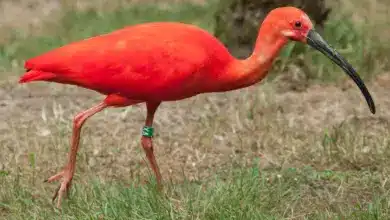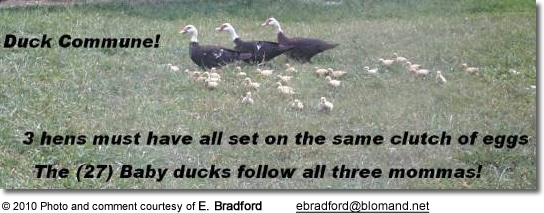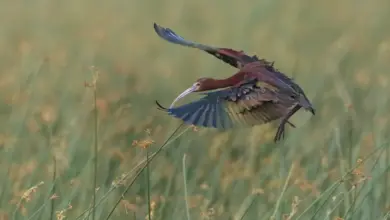Birds belong to a group called Avialae, which includes all theropod dinosaurs more closely related to living birds than to tyrannosaurs. This evolutionary relationship shows birds descended directly from small feathered coelurosaurian dinosaurs during the Jurassic period.

Primitive birds like Archaeopteryx evolved powered flight capabilities around 150 million years ago. But other major transitions shaped bird evolution, including the loss of teeth, the evolution of perching feet, increased brainpower, and the refinement of flight performance.
The adaptive radiation of birds produced the diversification of major groups as they exploited new ecological niches.
Following the extinction of most early avian lineages, the ancestors of today’s 10,000+ living bird species radiated in the Cenozoic era into the diverse forms we recognize today.
The Archaeopteryx
The iconic fossil Archaeopteryx (lithographica) represents the earliest definite bird, combining feathered wings with dinosaurian skeletal traits. Discovered in 1860, it provided direct evidence that birds descended from toothed reptiles, settling debates about their evolutionary origins.
Archaeopteryx lived around 150 million years ago during the Late Jurassic period. It evolved from small feathered coelurosaurian dinosaurs that gave rise to the first birds.
Archaeopteryx shared anatomical similarities with coelurosaurs, like the wishbone formed by fusing two collar bones and the distinctive three-fingered hand structure.
But Archaeopteryx also had distinctive avian features enabling powered flight. Its wings contained long asymmetrical flight feathers attached to the hand that generated lift.
The feathers created airfoil shapes across the wing surface to produce the aerodynamic forces needed for flapping flight.
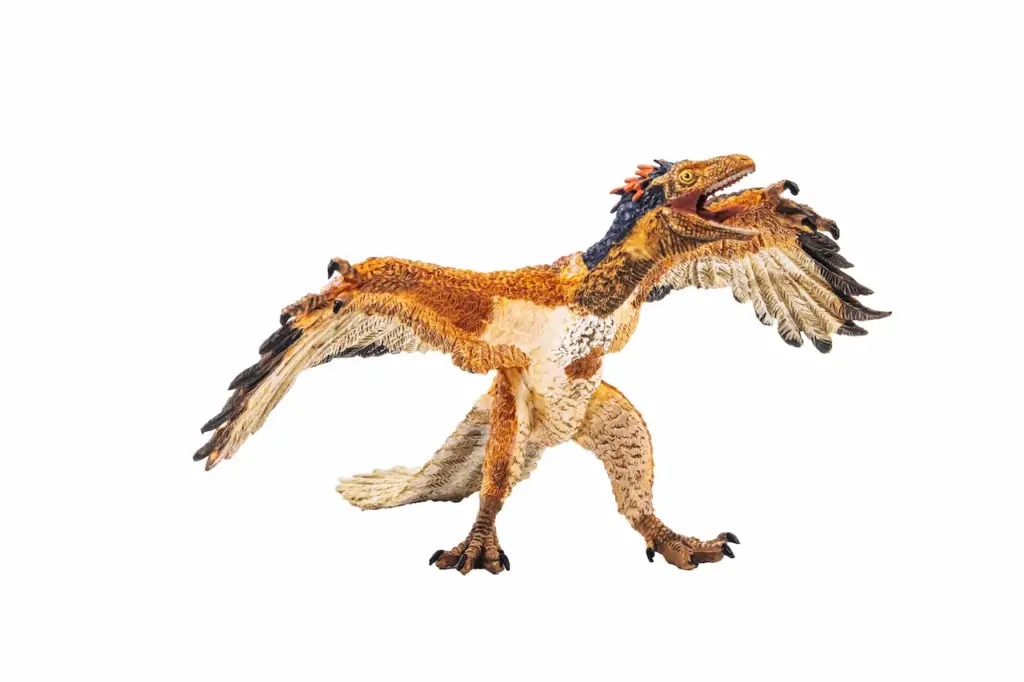
Yet Archaeopteryx still retained ancestral dinosaurian traits like teeth, a long bony tail, and clawed fingers on its wings.
This mosaic combination of dinosaur and bird features confirms Archaeopteryx as an important transitional fossil bridging the gap between coelurosaurs and later birds after it.
Species like Confuciusornis, Ichthyornis, and Hesperornis that evolved later in the Cretaceous period became progressively more like modern birds.
But Archaeopteryx provides a snapshot of the early transition from dinosaurs to birds and still stands out as one of the most significant fossils illuminating the origin of birds.
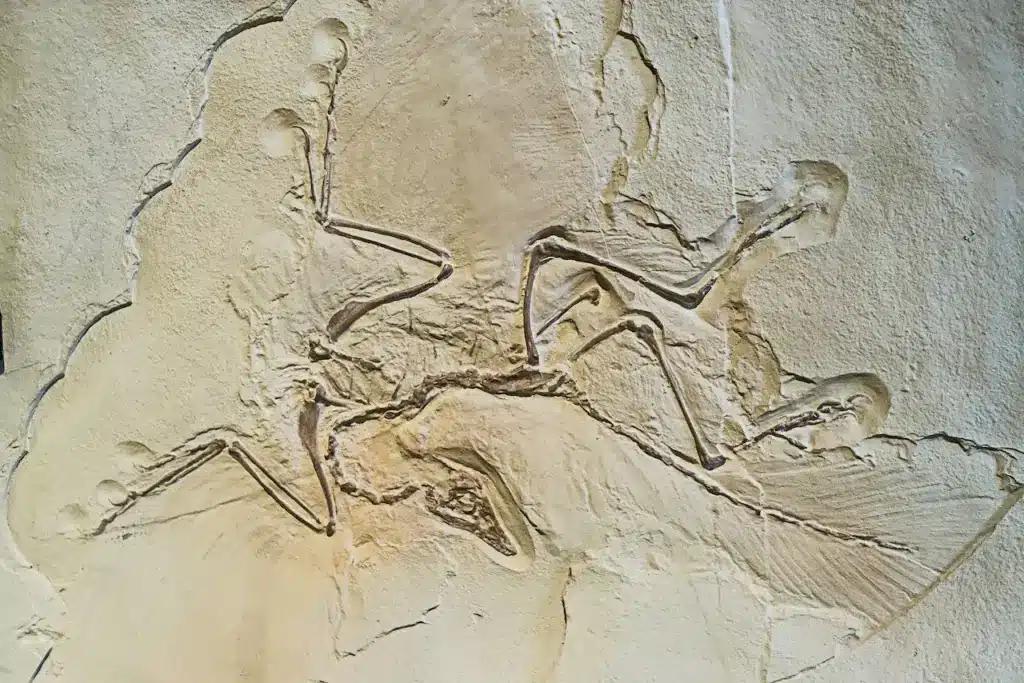
Dinosaur Origins of Birds
The direct connection between birds and dinosaurs was conclusively demonstrated in the 1970s by John Ostrom through fossils like Deinonychus showing clear dinosaurian relations to Archaeopteryx and other primitive birds.
We now know birds emerged from coelurosaurian theropod dinosaurs during the Mid-Late Jurassic period.
Feathered coelurosaurs like Anchiornis and Microraptors possessed asymmetric flight feathers on their forelimbs along with traits that foreshadowed later bird adaptations.
Small body size, feathered forelimbs, wishbones, elongated hands, and mobile shoulder joints all evolved incrementally in coelurosaurs. These adaptations primed certain dinosaur groups to develop the abilities of powered flight within the lineage that ultimately gave rise to birds.
Coelurosaurs were ancestrally carnivorous bipedal dinosaurs well-suited as the stock from which birds originated. Feathers likely first served functions like insulation and display before being exapted for aerial locomotion.
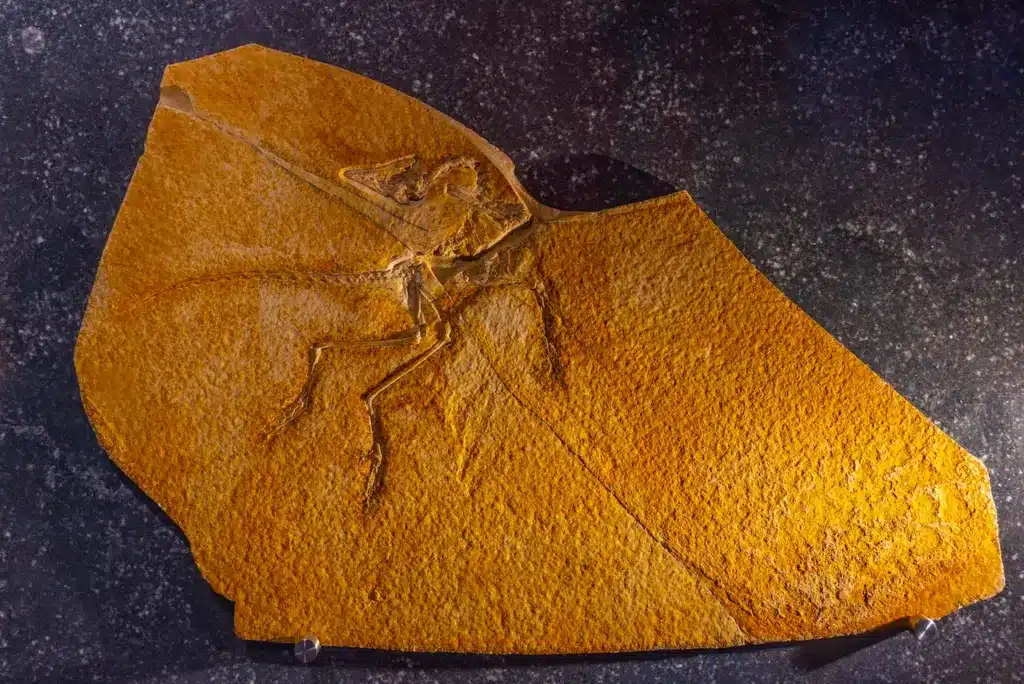
Bird Transition Fossils
Alongside Archaeopteryx, fossils like Anchiornis, Microraptor, Iberomesornis, and Sapeornis showcase the incremental changes between coelurosaurs and birds in the Jurassic/Early Cretaceous.
These remarkable feathered dinosaurs possessed asymmetrical flight feathers, perching feet, and wishbones. Some species bore wings with structural adaptations conducive to generating aerodynamic forces needed for aerial mobility.
But they also retained ancestral dinosaurian traits like teeth, long bony tails, and wing claws that became reduced in later birds. These mosaic organisms document the step-by-step acquisition of flight-related adaptations bridging the morphological gap between dinosaurs and birds.
China has proved a hotbed of these transitional fossils because of fine-grained lakebed deposits that exquisitely preserved feathers and other soft tissues. These crucial discoveries continue to reveal nuances about how birds originated from earlier dinosaurs.
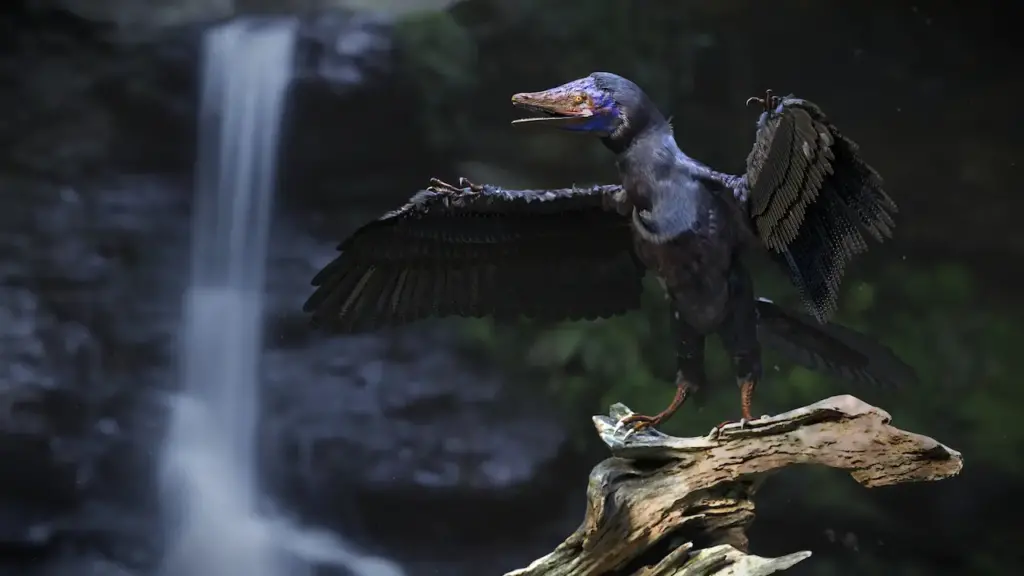
Dinosaur-Bird Link Controversies
The dinosaurian origins of birds were debated for decades before confirmation in the 1970s and 80s from fossils conclusively demonstrating their evolutionary relationship.
Some early researchers proposed alternatives to dinosaurs as bird ancestors, like ‘thecodonts’ (primitive Triassic archosaurs). This view became entrenched, leading to reluctance to accept the dinosaur-bird link first recognized by Thomas Huxley in the 1870s.
Later, germplasm theory led some scientists like renowned ornithologist Alan Feduccia to reject dinosaurian ancestry, claiming birds descended from unknown early archosaurs.
However, molecular and improved fossil evidence cemented the coelurosaur-bird connection as originally recognized over a century ago by Huxley.
Dinosaur-Bird Skeletal Comparisons
Skeletal evidence strongly cements birds as direct descendants of coelurosaur theropods. Important anatomical similarities include:
Teeth – Both coelurosaurs and primitive birds like Archaeopteryx had teeth set in sockets. This same dentition later disappeared in advanced birds.
Hands – The three-fingered hand structure of theropods is incorporated into the wings of birds, with major arm and shoulder bones retained.
Clavicles – The fused wishbone or furcula of birds derives directly from the separate collarbones still present in many dinosaurs.
Braincase – Birds inherited a braincase anatomy very close to that seen in advanced maniraptoran dinosaurs.
Pelvis – Pubic bones point backward in both coelurosaurs and primitive birds like Archaeopteryx, unlike in other reptiles.
Such homologous traits point to direct descent, given so many specialized avian characteristics trace their origins to dinosaur forebears. The skeletal evidence is powerful and extensive.
Feathered Dinosaur Revolution
The discovery of feathered dinosaurs beginning in the 1990s sparked a paleontological revolution. Sinosauropteryx, Caudipteryx, and dozens more fuzzy, plumed, and winged dinosaur species were unearthed, often exquisitely preserving feathers.
These Chinese feathered dinosaur fossils confirmed what was long theorized – that feathers arose first for insulation, display, or other functions among coelurosaurs before flight feathers enabled aerial capacities in birds.
We now know feathers characterized coelurosaur groups like dromaeosaurs (Velociraptor relatives), oviraptorosaurs (Caudipteryx), and bird-like troodontids (Anchiornis). This wide distribution implies they first evolved early among coelurosaur lineages.
These findings underscored birds inherited feathers from dinosaurs. Color patterns, wing surfaces, and even dinosaur courtship displays were revealed by these extraordinary fossils. Feathers trace through the dinosaur family tree directly into primitive birds.
Rise of Flight – Scenarios
Bird origins are intertwined with the evolution of flight. But how flight arose from dinosaurs remains debated, with two prominent competing scenarios:
Ground-Up
This view envisions flight evolving from agile two-legged (bipedal) runners on the ground. As forelimbs elongated for balance, feathers provided lift, enabling short hops and glides between bounds during high-speed running.
This scenario emphasizes similarities between dinosaur bipedalism and bird flight locomotion.
Trees-Down
Arboreal or climbing origins for flight are favored today. As feathered dinosaurs like microraptors climbed trees and lept between branches, they could have extended their reach via parachuting and gliding.
This aerial mobility improved as forelimbs became adapted for lift generation. Controlled aerial descents evolved incrementally into true powered flight.

Early Bird Diversification
Following the origin of flight capabilities, birds underwent evolutionary radiation in the Cretaceous period into a range of ecological niches and environments. Major diversification occurred among early avian groups:
Seabirds
The flightless Hesperornithiformes evolved powerful feet for diving and swimming after ocean prey like fish, filling an ecological role similar to today’s penguins and cormorants. These toothed Cretaceous seabirds represent early specialization for marine habitats.
Wading Birds
Groups like Ichthyornis developed long legs for wading in coastal marshes and shallows probing for fish. These Cretaceous shorebirds were important early divergences leading to modern wading bird diversity.
Landbirds
The amazingly successful Enantiornithes adapted as arboreal birds occupying terrestrial and tree-dwelling niches worldwide. Ranging from sparrow-sized to 1.5-meter wingspans, they were the dominant Cretaceous land birds prior to the extinction of this lineage along with dinosaurs.
This highlights just some of the major ecological diversification undergone by the bird lineage as they expanded into new niches across land, sea, and air.
Loss of Teeth – Edentulism
One of the major transitions during bird evolution was the loss of teeth, though the timing and pattern remain debated. Teeth added excess mass detrimental to flight, and beaks offered superior adaptations for specialized diets.
Most Mesozoic birds retained teeth, like the famous toothed diving bird Hesperornis. Some late-surviving toothed bird lineages like Pelagornithids lasted into the Paleogene.
However, new research shows tooth loss began by the Late Cretaceous in lineages leading to living birds. A study of embryonic birds reveals developmental genetic mechanisms for tooth loss were already operating before the extinction of toothed lineages.
So, like feathers arising before flight, genetic pathways silencing tooth formation evolved in late Cretaceous ancestors of modern birds. This exemplifies the often gradual evolutionary origin of major transitions.
Neornithes – Cenozoic Radiation
The diversification of Neornithes, encompassing over 10,000 living bird species, occurred mainly across the Cenozoic Era after the extinction of earlier toothed birds.
Neornithes comprise nearly all living birds aside from just a few species of Paleognaths like ostriches and tinamous. They include over 30 traditionally recognized orders diverging from the latest Cretaceous into modern ecological diversity.
Early Neornithes showed distinctions like vertebrae facet elaboration correlated with aerial maneuverability. They gave rise to ancient relatives of fowl, waterfowl, and other familiar groups before undertaking geographic colonization and niche specialization.
Key bird adaptations like refined flight mechanisms, respiratory systems, nest construction innovations, and brain elaboration all evolved incrementally among Neornithes as they diversified across land, water, and air.
Bird Skeletal Adaptations
Numerous skeletal modifications evolved in birds, conferring flight proficiency, agility, and skeletal strength while minimizing weight:
Fused Bones – For lightweight strength, bones, including hand elements, the pygostyle, and the shoulder girdle, underwent fusion for stability under the demands of powerful muscle forces.
Hollow Bones – Pneumatic bone containing air spaces reinforced by internal struts provided stability with minimal weight. Air sacs integrated into the skeleton further reduced mass.
Reduced Tails – Bony tails shortened as feathers took over tail functions. The fanlike tail of fused caudals, called the pygostyle, provides an anchor for steering feathers.
Keel – The sternum keel provides increased surface area for large-flight muscle attachment. These muscles power the wing downstroke to generate aerial thrust.
Wrist Articulation – Wrist bones evolved elaborate saddle joints, allowing the wing to fold tightly back against the body. This is key for reducing drag.
Such adaptations produced a lightweight, rigid airframe ideal for withstanding the physical demands of powered flight while optimizing aerodynamic efficiency.
Feather Diversity and Functions
Feathers stand out as a signature feature of Aves, exhibiting tremendous diversity in form and function:
Down Feathers – Fluffy down feathers trap insulating air to retain heat. They consist of loose barbs lacking hooked barbules. Soft down keeps birds warm and dry.
Contour Feathers – Stereotypical vaned feathers maintain the aerodynamic surface. Hooked barbules zip barbs together into a continuous vane and shaft. Their overlap forms a weatherproof coat.
Flight Feathers – Asymmetrical wing and tail feathers provide the aerodynamic forces needed for flight maneuvering. Specialized shape and stiffness confer different lift, drag, and control capacities.
Filoplumes – Hair-like filoplumes project from the skin between contour feathers to sense feather positioning for smooth airflow. This aids aerodynamic adjustments.
Bristles – Some birds, like turkeys, bear bristles around the eyes and mouth. Sensory bristles protect these areas and help sense food items.
The amazing diversity in size, shape, mechanics, and distribution of feathers enables the vast suite of functions and capacities they serve across the avian lineage.
Bird Reproductive Biology
Advanced reproductive strategies also promote avian success and diversification. Birds evolved innovations in courtship, territory defense, nest construction, and parental care.
Most birds are monogamous, at least for a breeding season, facilitating biparental care. However, only 3% of bird species exhibit lifelong monogamy. Many are serially monogamous across years or embrace polygamy.
Song learning, vocal mimicry, synchronized displays, and elaborate plumage ornaments evolve to attract mates. Territorial behaviors, including nest defense, promote feeding and protection of the nestlings.
Nest construction provides insulation, camouflage, and physical protection for the eggs and helpless nestlings. Nests stand as exemplars of animal architectural diversity and engineering.
Extended parental care is indispensable for birds to fledge chicks. Nest sanitation, feeding, defense, and teaching juveniles facilitate survival to adulthood and reproductive success.
These reproductive strategies promote reproductive success across diverse and challenging environments inhabited by birds.
Bird Ecology and Behavior
Key ecological and behavioral adaptations also facilitate the success of birds across environments:
Generalist Diets – Most birds opportunistically feed on seeds, vegetation, insects, fish, and more. This dietary flexibility lets birds persist in diverse habitats. Frugivores disperse seeds.
Communication – Birds employ elaborate visual displays and hundreds of distinct vocalizations for territory defense, courtship, signaling alarm, and coordinating flocks. Some birds can imitate sounds.
Migration – Many birds migrate vast distances to occupy seasonal breeding and wintering grounds. Some Arctic terns log over 40,000 miles annually during migration. It incurs tradeoffs but expands the range.
Flocking – By foraging and moving in flocks, birds reduce predation risk through improved vigilance, information transfer, predator confusion, and safety in numbers. Flocking requires social coordination.
Nest Parasitism – Some birds exploit others by laying eggs in their nests to avoid parental care. Obligate nest parasites like cuckoos demonstrate advanced mimicry to evade detection.
Such flexible behaviors enable diverse resource use, seasonal migrations, information sharing, predator avoidance, and other advantages that promote the success of the avian lifestyle worldwide.
Bird Intelligence and Cognition
Many birds exhibit sophisticated intelligence, cognition, and the ability to solve problems. Corvids like crows and parrots stand out for their advanced brains relative to size:
Tool Use – Some birds use tools, like New Caledonian crows that craft hooked sticks to winkle out insects. Vultures hurl rocks to break eggs. Woodpecker finches use cactus spines to extract food.
Problem Solving – Studies on crows show they can solve multi-step problems like using hooks to get rewards and moving boxes to access food. They understand cause-and-effect cognitive relationships.
Communication – Parrots can mimic human words through cognition rather than just mimicry. Some parrots perform cognitive tasks comparable to great apes. Many birds learn and improvise elaborate vocal sequences.
Deception – Crows recognize individual human faces and communicate scolding warnings. Some birds lead predators away from nests by feigning injury.
Social Learning – Many birds exhibit cultural transmission of innovations like tool use. Vocalizations are learned rather than entirely innate. Some birds cooperate with kin through tasks.
Diverse cognitive skills related to tool use, manipulation, representation, sociality, and learning are observed in birds with advanced brains. This opens insights into the evolution of intelligence across vertebrates.
Conclusions
From theropod dinosaurs like Velociraptor, birds inherited traits including feathers, wishbones, and three-fingered forelimbs that were incrementally adapted for flight. Powered flight opened up new ecological niches, promoting rapid diversification.
Improved flight abilities, intelligent behaviors, skeletal modifications, and reproductive strategies have enabled the evolutionary success of birds for over 150 million years since Archaeopteryx first took wing.
Today, surviving lineages of Neornithes comprise over 10,000 diverse bird species occupying terrestrial, arboreal, aquatic, and aerial environments worldwide.
Ongoing fossil discoveries continue revealing nuanced evolutionary transitions, incrementally illuminating the sequence of adaptations by which ceremonial feathered dinosaurs transformed into highly successful powered flying birds that persist as one of Earth’s most widely distributed and diverse vertebrate lineages.

